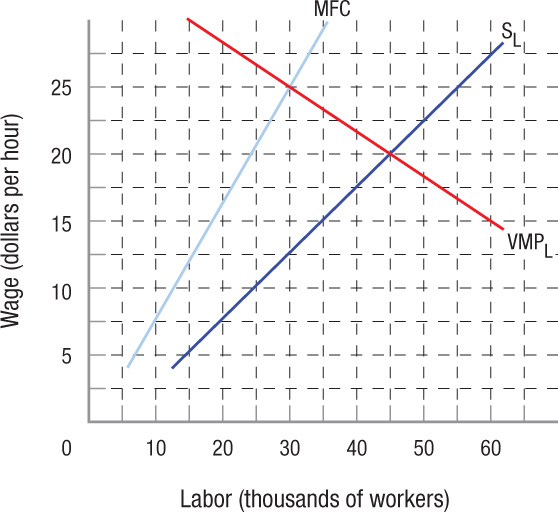Appendix Questions and Problems
- The figure below shows the supply of labor, marginal factor costs, and the demand for labor for a firm that is large enough that it is essentially a monopsonist in the community in which it operates. Assume that all workers are paid the same wage and that they work 2,000 hours per year (40 hours a week for 50 weeks).

Question
IqpT9uj1snUA/gT3PhwCQE8EArLM8K3O04X12ZBERSqy24En0QZMTxGE6RH8zda5tDtL4deHbDf5QjvagOgCE1xWI3rxUFLQLzNW7AE0V3qZWmJI61VVvQnICyxYO3gGT4gfNBFq7gw=ProbA 11 1a. What is the total wage bill (total wages paid by the firm) for this monopsonistic firm?Question
PRJuetOCAM11C4+EEf5T2Q3schivm+/VuUlwN9XgJ4vIVftcnGlQqSqsC3mgl9XY2Z7yB9rFpE9hm7EniKbfut4L1ItBBNC0kS1F4XfN67ZALVg4C3i3osc+NG1WU2A9cYiCAs0e8mjCM1BwhbFJLsHtYJsWUMAW487RorMT7FY=ProbA 11 1b. If the firm was actually hiring from a competitive labor market, what would be the total wage bill for the firm?Question
vuCED4pziOUN88e6fLCaj3Q5Ck0g3dsMfcRWBHp0TzoVrwiuQDBdq+k3SqMu5ymFgVkC8/ns2p0Crku9cDB1klEbuUoYxl0piurJ9q/o2g+EDL1oAm1zuOasbWKlldr/ProbA 11 1c. What is the total value of the monopsonistic exploitation of labor by this firm?Question
4vXCXxu2P5qhYLvgmJSnR+bzZVijTjSMEvciaUEwmsX2SKi8TQevj0uKaW6X/R8fxzS2x/l+OSIVCtjdHqmkg8U9q1UUzkkl0FqktpINm9Y=ProbA 11 1d. Is the firm a competitor or a monopolist in the product market?
Question
WUlXbvkJjuoEk7/FtMGxRi0pqd3gz2wqCGci7UISbI8FFtIHUig1TtPuKfZvhqq1UQbS752NVU7B9XiAkbApCBJuOcOriIq0DkG5Y300rRxSHl9YE4DnUHQqzOxXCtq/clbxptDVjdkqpPKdnQlTTnv2bkwPs9i9dQMFjRs2RIGrlUXfFGay2iwxapBzyhagProbA 11 2. Would unions be more likely to organize successfully in highly competitive markets or in markets with monopsony power? Explain.